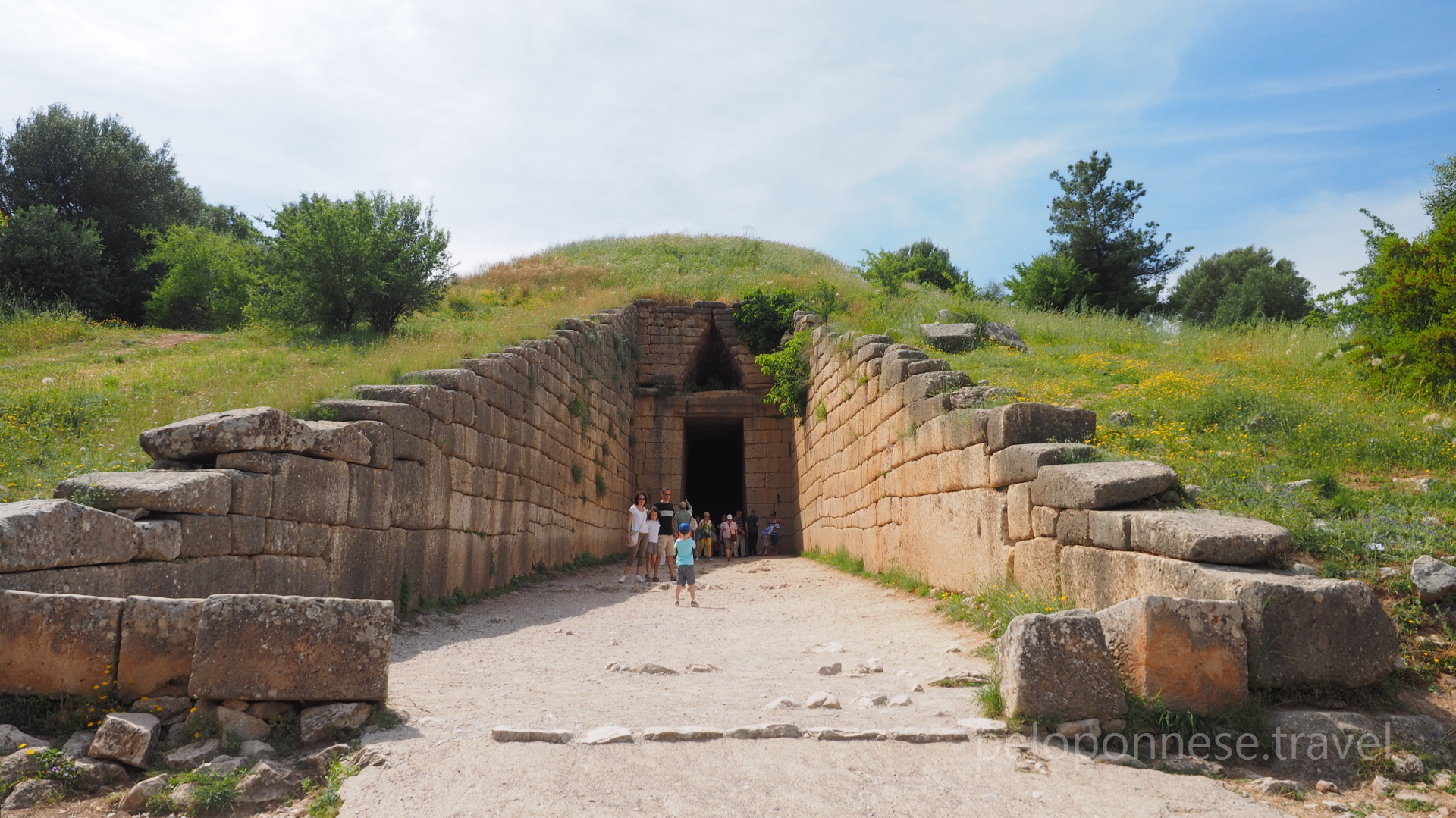‘Rich in gold’ Homerian Mycenae, a location with great history throughout the centuries. If you love archaeology, you are in the right place, as a walk in the mycenaen graves will make you feel you pleasure of the discovery of worldwide unique archaeological findings. As for the village of Mycenae, Horvati until 1928, has preserved 1970-1980 style : cafes, souvenir stores of ancient greek style , it really worths exploring. Local people are mainly farmers, but most of them occupy in the tourist industry , arriving to admire Atreides Tomb.As a matter of fact, cosmopolitan Nauplio, along with even more holiday destinations in Argolida, are a few km away and those who choose to spend their holidays there , should definitely visit Mycenae.
HOW TO GET THERE:
Mycenae is 150km far from Athens. Driving to the highway Athens-Tripolis , you will find the signs to Argos- Nauplio and before reaching Nauplio follow the way to Mycenae. Moreover , there is a bus service available from Athens.
WHAT YOU CAN SEE:
“Rich in gold” Mycenae , the kingdom of Agamemnon, who was first mentioned in the Homeric Poems, is the most important and prosperous centre, of Late Bronze Age. Pausanias (2.16.3) refers that the name of the new town Mycenae comes from either because the cap(mykes) of the stealth of his sword was dropped there , or because there he found a spring gushing water- Perseia spring-under the route of a mushroom. Mycenae was built between two high hills- Profitis Ilias(805m) and Sarah(660m), in a location dominating in the Argolic Plain and had the control of sea and land transport.The oldest human activity is dated to 7th century B.C. during the Neolithic Period.It was inhabited until historic time, however, most monuments still seen today belong to the period of Late Bronze Age (1350-1200 B.C) Around 1700B.C. aristocratic and hegemonic families appeared as it can be concluded by the impressive tombs and pottery material name Circle B Grave. This development continued in the beginning of the Mycenaen Period around 1600 B.C. , when a big building was constructed on top of a hill, a second stone enclosure, Circle A Graves, along with a lot of tholos tombs.As the findings discover , mycenaen hegemonies , were powerful and participated in a complex commercial network with the Mediterranean countries. The construction of palaces,visible today, is dated around (1350B.C) in Late Helladic period IIIA2 . The fortification of the Acropolis started then, which includes 3 phases. The first enclosure was built in a style known as Cyclopean, on a rock. 100years later, in the Late Helladic IIIB1 period , the fortification moved southwestern and the Lion Gate was built , the central column of great significance. The religious center and Circle A Graves , were part of the site, transformed in a location of worship , with the elevation of the initial level. Then, it is likely that it was constructed the tholos tomb, known as The Treasury of Atreus, with the huge beehive tholos and impressive gate. Around 1200 B.C. in the Late Hellinistic Period, after an extensive damage , probably an earthquake , the expansion of the walls to the northeastern side of the hill was constructed , in order to house the subterranean spring. Consecutive destruction combined with fires led to the abandon of the area around 1100B.C.After the collapse of the system, the hill remained restrictedly inhabited until the Classical Period. In the meantime, local heroic worship was created in the area, based on the mycenaen fame, transferred to the greek people by Homer, while on the summit of the hill, a temple dedicated to Hera or Athena was built. In 468B.C. , after the Persian Wars, Argos conquered Mycenae, and razed the fortifications. Later, during the Hellenistic Period, the people of Argos repaired the prehistoric walls and the ancient temple, constructing a small theatre located over the Tomb of Klytaimnistra. During the following centuries, the site was abandoned and it was already deserted when Pausanias visited it in the 2nd A.C. The Cyclopean Walls of Mycenae , still visible in the centuries , has become a tourist attraction for many researchers and archaeology lovers., who did not hesitate to ruin the site during the 18th -19th cent., based on the indifference of the Turkish.In 1837 , after the Greek Liberation , Mycenae was preserved by the Archaeological Society of Athens, which still carries out excavations.In 1941, the archaeologist K.Pittakis, restored the Lion Gate and in 1876 Henry Sleeman , after trial shafts in 1874, he commenced his excavations , which revealed 5 graves of Circle A Graves, under the supervision of P.Stamatakis, who continued the excavation in 1876-1877 , revealing the sixth grave. Since 1998, there have been in progress works of restoration and preservation by the Organisation of Monument Restoration of Epidaurus and later by the Committee of Mycenae, established in 1999 by the Ministry of Culture.
LOCAL FESTIVALS:
On 25th of July, the commemorating day of Agios Panteleimonas , the local festival is organized with local dishes and traditional dance. Don’t miss trying local pork meat , which is served along the provincial roads and highways.

